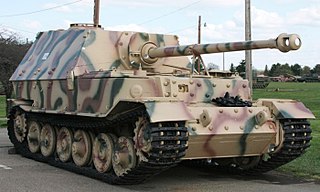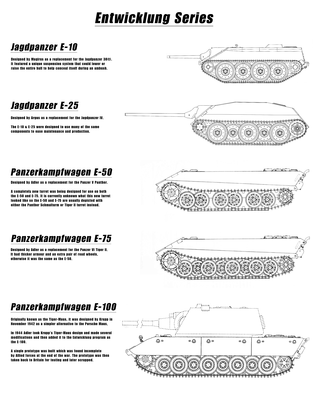
The Tiger II was a German heavy tank of the Second World War. The final official German designation was Panzerkampfwagen Tiger Ausf. B, often shortened to Tiger B. The ordnance inventory designation was Sd.Kfz. 182.. It was also known informally as the Königstiger. Contemporaneous Allied soldiers usually called it the King Tiger or Royal Tiger.

The Panzer II is the common name used for a family of German tanks used in World War II. The official German designation was Panzerkampfwagen II.

This article lists production figures for German armored fighting vehicles during the World War II era. Vehicles include tanks, self-propelled artillery, assault guns and tank destroyers.

Panzerkampfwagen VIII Maus was a German World War II super-heavy tank completed in late 1944. It is the heaviest fully enclosed armored fighting vehicle ever built. Five were ordered, but only two hulls and one turret were completed, the turret being attached before the testing grounds were captured by advancing Soviet military forces.

The Panther tank, officially Panzerkampfwagen V Panther with ordnance inventory designation: Sd.Kfz. 171, is a German medium tank of World War II. It was used on the Eastern and Western Fronts from mid-1943 to the end of the war in May 1945.

Elefant was a heavy tank destroyer used by German Panzerjäger during World War II. Ninety-one units were built in 1943 under the name Ferdinand using VK 45.01 (P) tank hulls which had been produced for the Tiger I tank before the competing Henschel design had been selected.

The Jagdpanther, Sd.Kfz. 173, was a tank destroyer built by Germany during World War II. The Jagdpanther combined the 8.8 cm Pak 43 anti-tank gun, similar to the main gun of the Tiger II, with the armor and suspension of the Panther chassis.

Nazi Germany developed numerous tank designs used in World War II. In addition to domestic designs, Germany also used various captured and foreign-built tanks.

The Entwicklung series, more commonly known as the E-Series, was a late-World War II attempt by Nazi Germany to produce a standardised series of tank designs. There were to be standard designs in five different weight classes from which several specialised variants were to be developed. This intended to reverse the favor of extremely complex tank designs that had resulted in poor production rates and mechanical unreliability.

This article deals with the tanks serving in the German Army throughout history, such as the World War I tanks of the Imperial German Army, the interwar and World War II tanks of the Nazi German Wehrmacht, the Cold War tanks of the West German and East German Armies, all the way to the present day tanks of the Bundeswehr.

The Tiger I was a German heavy tank of World War II that began operational duty in 1942 in Africa and in the Soviet Union, usually in independent heavy tank battalions. It gave the German Army its first armoured fighting vehicle that mounted the 8.8 cm KwK 36 gun. 1,347 were built between August 1942 and August 1944. After August 1944, production of the Tiger I was phased out in favour of the Tiger II.

The VK 30.01 (P) was the official designation for a heavy tank prototype proposed in Germany. Only two prototype chassis were built. The tank never entered serial production, but was further developed into the VK 45.01 Tiger (P). Porsche called it the Typ (Type) 100.
The VK 45.01 (P), also informally known as Tiger (P) or Porsche Tiger, was a heavy tank prototype designed by Porsche in Germany. With a dual engine gasoline-electric drive that was complex and requiring significant amounts of copper, it lost out to its Henschel competitor on trials, it was not selected for mass production and the Henschel design was produced as the Tiger I. Most of the already produced chassis were rebuilt as Elefant Panzerjager tank destroyers.
The Versuchskonstruktion 30 were two series of tank designs by Germany in World War II, originally intended as heavy 'breakthrough' tanks, but later switching completely to designate medium tanks to succeed the Panzer III, IV, and the planned VK 20 series tanks. These were requested in response to the Soviet T-34 and KV-1 tanks, with far heavier armour and armament than the mobile armoured vehicles fielded by the Wehrmacht at the time. Many German companies submitted projects, including Maschinenfabrik Augsburg-Nürnberg (MAN), Daimler-Benz (DB), Henschel, and Porsche. The winning entry tanks would go on to become the famous Tiger I and Panther tanks, capable opponents to the T-34, but it was ultimately too late and at too small of a scale to affect the course of the war.

The VK 30.01 (D) and VK 30.02 (D), also known as VK.3001 (DB) were two tank designs made by Daimler Benz submitted for the VK 30 project for a 30 tonne tank to be used by the German army.

The VK 30.01 (H) is a German prototype heavy tank developed by Henschel in Germany during World War II. It was rejected for production likely due to being outdated by the time it was meant to be produced. The chassis from this project went on to form the chassis for the Sturer Emil self-propelled anti-tank gun project.

The Panzerkampfwagen II Ausf. L "Luchs" is a German light tank from the Second World War, developed between 1940 and 1942 by Daimler-Benz and MAN. The Luchs was the only Panzer II design with the Schachtellaufwerk overlapping/interleaved road wheels and "slack track" configuration to enter series production, with 100 being built from September 1943 to January 1944 in addition to the conversion of the four Ausf. M tanks. Originally given the experimental designation VK 13.03, it was adopted under the alternate name Panzerspähwagen II and given the popular name Luchs. The Luchs was larger than the Panzer II Ausf. G in most dimensions. With a six speed transmission, it could reach a speed of 60 km/h (37 mph) with a range of 260 km (160 mi). The FuG 12 and FuG Spr radios were installed, while 330 rounds of 20 mm and 2,250 rounds of 7.92 mm ammunition were carried.
















